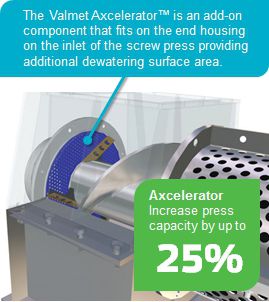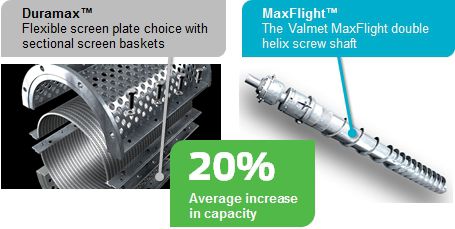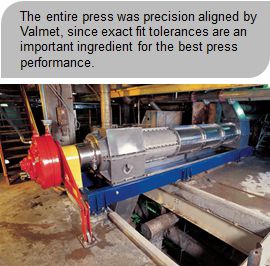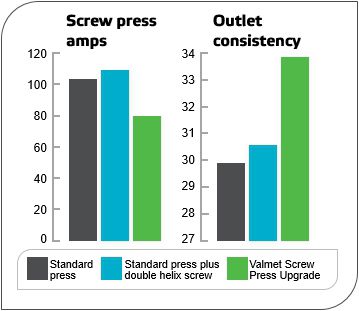Refining - More water out for less energy in, a case study
Upgraded Optimum™ TMP screw presses at Norpac
Case Summary

Customer challenge: Water removal
Solution: Valmet Screw Press Upgrade
Results: Increased dewatering. Energy saving.
Upgraded Optimum TMP screw presses provide consistent secondary refining consistency for low press inlet consistency. The increased dewatering capacity solved a major design hurdle for a TMP mill. Energy savings of 12% are a bonus.
Background
A major TMP producer in North America, with nine refining lines in two separate mills, was in the process of modifying its refining and screening processes to reduce energy consumption. Valmet was chosen to carry out the major process rebuild of the original mill that was commissioned at the end of the 1970s.
A challenging process
During the design process, a major hurdle had to be overcome with regards to the dewatering capacity of the existing pulp thickening screw presses before the secondary refiners. With the installation of new Valmet interstage screens, the inlet consistency was expected to drop from 5.5% to between 3.5 and 4.5%, and so the feed flows would change from 650-750 gpm to 550-900 gpm.
With a lot more water to be removed, concern was raised about the ability of the existing presses to provide the high outlet consistency necessary for high quality secondary refining. Pre-thickeners would be undesirable since they would require more floor space, perhaps even a building addition, which might jeopardize the economic viability of the entire project. Valmet was therefore charged with the responsibility of rebuilding the existing screw presses, in order to obtain greater dewatering capability and achieve an even outlet consistency at a targeted 35%, while dealing with changes in freeness and inlet flow. Certainly a tall task, but one which was essential for the entire project.

The rebuild solution
The first step was to rebuild one screw press with the Valmet Screw Press Upgrade package and compare it in a production trial to the dewatering capacity of two existing presses; one of which has a twin helix screw and the other has standard press parts. The rebuilt press was equipped with a new MaxFlight double helix and new compression ratio screw shaft, an Axcelerator inlet module which adds dewatering surface area and new screen baskets.

MaxFlight screw shaft and DuraMax screen plates increase capacity.

The other presses were unable to operate satisfactorily through all conditions, resulting in low refiner loads. As feed consistency was decreased to 3.5%, the older presses were unable to maintain a plug, resulting in a loss of load on both refiners.
The rebuilt press operated well in all the conditions, having a maximum of 5 psi inlet pressure and with the refiner running at full load. In all cases, the rebuilt press provided considerably higher outlet consistencies than the older presses, with results above the 35% target value.

Expect excellent results with Valmet Screw Press Upgrade.

Even with all that mills must face in the rough landscape of the industry today, it is important to remember that there is no problem that cannot be fixed. Valmet is pleased to work together with mills to help navigate through the issues that you face, and find solutions that will allow you to maintain your place as market leaders. The Valmet renovation program can be a viable solution for any mill and is available for a wide range of equipment types and models. It is a practical solution for any mill looking to revive outdated and worn equipment, which would bring your mill back up to maximum production levels.
For more information about improving your refining process while saving energy, contact your Valmet representative.